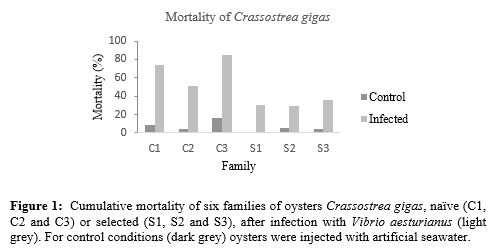ANTIMICROBIAL PEPTIDE ANALYSES OF SELECTED AND NAÏVE Crassostrea gigas OYSTERS TO Vibrio aesturianus PATHOGEN
Introduction
Oysters are filter-feeder animals and as a result they are in permanent contact to diverse communities of microorganisms [1]. Bacterial and virus outbreaks represent a major threat to the oyster industry, being responsible for severe diseases that often leads to massive oyster mortality and harsh economic losses [2, 3]. Pathogen recognition and disease control in oysters are mediated by an innate immune system, in which antimicrobial peptides play a key rule. In this study, the susceptibility of naïve or selected oysters Crassostrea gigas to infection with Vibrio aestuarianus has been approached, regarding mortality and expression of genes which codify for antimicrobial peptides.
Material and Methods
Six families of C. gigas, 3 naïve and 3 selected for their higher resistance to V. aestuarianus, were tested for infection with V. aestuarianus. 12 oysters per family were distributed in each tank (72 oysters/tank). All oysters for three of the tanks were injected with 100 µl of bacterial suspension (106 bacteria/oyster) into the adductor muscle (infected condition), while oysters of the three other tanks were injected with artificial sea water (control conditions). Mortality was recorded every day during 30 days, and for each tank, three live oysters of each family were sampled at 24h, 48h and 72h post-infection, for haemolymph, mucus and tissue collection. Haemolymph was centrifuged and haemocytes were kept on trizol for gene expression studies by real-time PCR. Plasma was used for protein and NO quantifications. Also, mucus was kept at -80ºC for further studies of antimicrobial activity and tissue will be used for V. aestuarianus quantification to verify the infection progression.
Results
Results of cumulative mortality reveal higher mortality in the infected conditions (mean = 51%) than of control condition (mean = 6%). Then, when infected with V. aestuarianus, selected families showed a lower mortality (mean = 32%) than naïve oysters (mean = 70%) (figure 1). Regarding protein content and NO, no significant differences were found among resistant and naïve oysters in plasma; still, results seem to point to higher protein content of the resistant animals even in control conditions. Four families were selected for gene expression analysis based on mortality results (the two best and the two worst). Overall, resistant and naïve families show different patterns of gene expression. For control conditions, in general, genes were higher expressed in resistant oysters. Additionally, either facing a bacterial challenge or in control conditions, some genes involved in host defense, as for instance defensin (Cg-Defhs), exhibited a higher expression in resistant families, at all sample time points.
Discussion
The ability to defend against a pathogen can be affected by environmental, genetic factors or combination of both [4]. It is also known that recognition of microbial products leads to production of a large range of antimicrobial molecules [5]. Therefore, in our study, families of naïve and selected oysters were chosen to be submitted to a bacterial challenge with V. aesturianus. Results of mortality are in agreement with the selection scheme developed, indicating that the selected families have a higher resistance to the infection by V. aestuarianus. Moreover, it appears to be in accordance with expression results of genes related with defense against pathogens. The higher levels of defensins in resistant families and other genes involved in host defense can be associated with a more efficient response to infection. Antimicrobial activity studies are also being performed in mucus samples of all families in order to understand if there is a different profile among resistant and naïve families.
Acknowledgments
This work was also supported by the project CRAGIAMP-POCI-01-0145-FEDER-030232, co-financed by COMPETE 2020, Portugal 2020 and the European Union through the ERDF. Ana Garcia is supported by a BYT-FCT PhD Grant (UI/BD/150907/2021).
Bibliography
[1] E. Bachère et al., “The new insights into the oyster antimicrobial defense: Cellular, molecular and genetic view,” Fish Shellfish Immunol., doi: 10.1016/j.fsi.2015.02.040.
[2] L. Dégremont, C. Garcia, and S. K. Allen, “Genetic improvement for disease resistance in oysters: A review,” J. Invertebr. Pathol., 2015, doi: 10.1016/j.jip.2015.05.010.
[3] M. Leprêtre et al., “Comparative Proteomics of Ostreid Herpesvirus 1 and Pacific Oyster Interactions With Two Families Exhibiting Contrasted Susceptibility to Viral Infection,” Front. Immunol., 2021, doi: 10.3389/fimmu.2020.621994.
[4] P. Azéma, J.-B. Lamy, P. Boudry, T. Renault, M.-A. Travers, and L. Dégremont, “Genetic parameters of resistance to Vibrio aestuarianus, and OsHV-1 infections in the Pacific oyster, Crassostrea gigas, at three different life stages,” Genet. Sel. Evol., 2017, doi: 10.1186/s12711-017-0297-2.
[5] M. Gonzalez et al., “Evidence in oyster of a plasma extracellular superoxide dismutase which binds LPS,” Biochem. Biophys. Res. Commun., 2005, doi: 10.1016/j.bbrc.2005.10.075.
